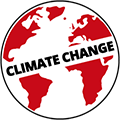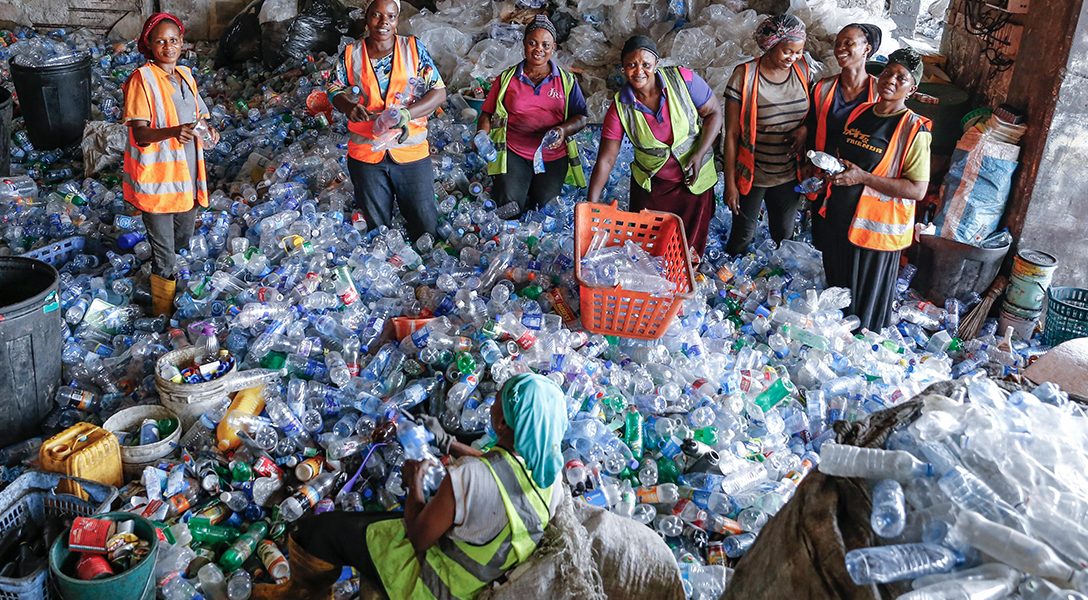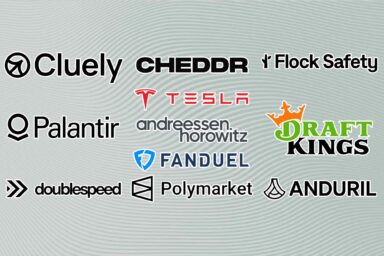A new documentary depicts a global plastics crisis that is only getting worse.

It’s no secret that plastic waste products — especially single-use items — are polluting the land, sea, and air. The Story of Plastic is a new documentary that focuses on a global movement — called Break Free From Plastic — and shows activists using many methods to clean up plastic waste while working to reduce our use of a wide range of plastic products.
In this new WhoWhatWhy podcast, Brett Chamberlin, the impact producer for the documentary, says that cleanup efforts can’t keep up with the expanding production of plastics, which are a major profit center for the oil and gas industries.
And while “Big Plastic” corporations have pledged $1 billion toward cleanup efforts, they are spending over $200 billion to build even more plastic plants.
With the virtual collapse of the global recycling marketplace, landfills are choking with plastic waste — and plastic debris clogs creeks, rivers, and beaches, culminating in a number of floating “gyres,” the massive collections of plastic waste drifting in our oceans.
Chamberlin notes that microplastics and “nurdles” (little pellets of plastic) have even entered the food chain.
Environmental activists are fighting back. One of them is Diane Wilson, a veteran shrimp boat captain from the Houston area. On October 15, 2019, Wilson’s group won a court victory that orders Taiwan’s Formosa Plastics to pay $50 million for polluting waterways, to comply with “zero discharge,” and to clean up existing pollution.
The Story of Plastic premiered at the Mill Valley Film Festival and will be screened at other festivals before full release. It is directed by Deia Schlosberg and produced by the nonprofit that delivered the viral film The Story of Stuff. Get screening information and view short videos at StoryofPlastic.org.
Click HERE to Download Mp3
Full Text Transcript:
As a service to our readers, we provide transcripts with our podcasts. We try to ensure that these transcripts do not include errors. However, due to time constraints, we are not always able to proofread them as closely as we would like. Should you spot any errors, we’d be grateful if you would notify us.
| Peter B. Collins: | Welcome to another radio WhoWhatWhy podcast. In San Francisco, I’m Peter B. Collins. It’s no secret that our planet is awash in plastic waste. Everywhere you look, you see shreds of single use plastic bags, crushed single use plastic water bottles, and our oceans are now filled with huge trash dumps that are called gyres, and there is apparently no end in sight. Brett Chamberlin joins me today. He’s an impact producer from a brand new documentary film which is based on, or an extension of, the organization that brought you The Story of Stuff, and their new film that just premiered worldwide at the Mill Valley Film Festival a week or two ago, is called The Story of Plastic. Brett, thanks for being with us today. |
| Brett Chamberlin: | My pleasure, Peter. Thank you so much for inviting me to join you. |
| Peter B. Collins: | Well, I think that you and your team, and Stiv Wilson is one of the drivers of this project, have done a fabulous job of really explaining the mountains of trash that we’re seeing, mostly plastic stuff, on land and the real dangerous development of these massive piles of trash that are floating in the sea. And your film, as I said, debuted at the Mill Valley Film Festival, and I have to say you and your team did a great job of describing the problem and helping us understand that the industry is not slowing down. In fact they are expanding their capabilities for producing plastic products worldwide. So congratulations on an excellent documentary. Let’s pause for a second and just talk about the origins here of The Story of Stuff, because that became a viral video sensation and helped a lot of people understand that our materialism has gone a little too far. |
| Brett Chamberlin: | That’s right, Peter. The Story of Stuff project began, as you know, as an animated explainer short documentary released in 2007 under the title, The Story of Stuff, and it became one of the first cause-oriented viral videos in the then baby YouTube way back when in 2007. And the documentary attempts to take a look at the way that we consume and dispose of stuff, all of the things in our material economy, from our clothing to our electronics, and of course the consequences and impacts on people and planet at every step of that system, from the extraction of the raw materials used to produce them, to their consumption and distribution, and ultimately their end of life in the environment, landfills or incinerators. |
| Brett Chamberlin: | Now, we of course have a consumer economy here in the US. That’s one of the key sources of economic activity, but so much of it goes unexamined. So it was an attempt to really step back and link a number of issues from social and environmental and economic justice under one holistic framework. Since then we’ve produced a series of other animated Story Of videos from The Story of Electronics to Cosmetics to Water and Bottled Water, in an attempt to zoom in on different steps and material types within that system, and those videos have helped to mobilize the global community of individuals working to take action to change the system for the better. |
| Peter B. Collins: | And so when we look at plastics, there really was a revolution back in the 1950s, 1960s, as the oil and petrochemical industries emerged with a whole new line of handy devices from Tupperware to, we have so much plastic in our cars now, and so plastics have made an important contribution to our consumer lifestyle. At the same time, we have been grossly negligent about the side effects and particularly about the long life that plastic waste has. |
| Brett Chamberlin: | That’s precisely correct. Certainly plastics are a miracle material, and they provided incredible opportunities in their creation. It really was viewed as a miracle material when they first came onto the market in the 1960s. Unfortunately though, one of the qualities as you note is their longevity. One of those qualities that makes them so valuable, their longevity is of course what causes such severe problems at their end of life when they end up in landfills, incinerators, or the environment. |
| Brett Chamberlin: | Now another problem is unfortunately that increasingly plastics are not being used for those purposes in which it does make sense to have long lasting materials. But increasingly plastics are being used to create single use “disposable” items, principally packaging or other throw away goods that are used once and then spend the rest of their life in landfills of the environment if they’re not incinerated causing additional pollution issues. |
| Brett Chamberlin: | Now the production of plastics is also increasing at an enormous rate. In fact, half of the plastics ever created have been produced in the last 13 years. So this problem has exploded. And part of the reason that we’re seeing so much attention to plastic and plastic pollution recently is that the scale of the problem has increased so dramatically. And unfortunately industry is continuing to invest hundreds of billions of dollars in increasing their production capacity here in the US and other oil producing countries. |
| Peter B. Collins: | And, Brett, let me, let me jump in because the most striking segment of the film and the data point that I came away with, I tried to take a few notes in a dark movie theater, but this really stuck with me that the oil and plastics industries have benevolently announced that they are grouping together to raise a measly $1 billion to address the worldwide plastic waste problem. And in the very same time frame, they are investing over $200 billion in new facilities to produce plastic products, not only in the United States but across the Earth. |
| Brett Chamberlin: | That’s precisely correct. You know, certainly big plastic as we refer to them, that is the petrochemical industry which produces much of the plastic that we see in the world. And of course the fast moving consumer goods companies, which integrate those plastics into their supply chains and use them to package their products, would really like for us to keep the focus on the end of life. So they’d like for all the attention and of course the investment as well to remain on trying to clean the plastic out of the oceans or pick up beaches or do advertising against individual litter bugs. But that really is an effort to shift the focus and shift the blame on the individual consumers rather than admitting that we are seeing so much dramatic plastic pollution entering the environment because there’s so much low and no value plastic entering the economy. |
| Brett Chamberlin: | So the film is in part an effort to look upstream, to draw the attention back from the focus that has dominated media and previous documentaries on plastic, on beaches and in the ocean, and look at who’s creating all this plastic in the first place and how can we hold them responsible. |
| Peter B. Collins: | So Brett, as we look at the scope of this problem and the minimal efforts that the industry is doing to police the waste that it has created, your film depicts activists in many countries around the world who are picking up the slack and running their own local programs to clear out streams, to clear up beaches. But also to address the monumental problem of the plastic waste that’s floating in our oceans. |
| Brett Chamberlin: | Absolutely. And those activists are united under the banner of a movement called Break Free From Plastic, which began about three years ago as an effort to unify the efforts of a variety of individual activists, organizations and NGOs, and to bring them together with a unified global strategy to tackle plastic pollution with a realistic view of who’s really responsible and what the most impactful points of intervention are. Some of the activists profiled in the documentary are really on the front lines of this issue and they’re really working to bring responsibility to bear on the corporations who need to be held accountable for this problem in the first place. |
| Peter B. Collins: | And one of the heroes of mine who is depicted in the film is a woman named Diane Wilson, who is a shrimper on the Gulf Coast of Texas. And the waters where she has been fishing for years have been increasingly polluted by effluent from a, I believe it’s owned by Formosa, a plastics plant in the area there. And just last week she won, or she and her group won, a big victory in court. Can you tell us a little about that? |
| Brett Chamberlin: | Absolutely. So there are a number of plastic production facilities located along the Gulf of Mexico coastline in the greater Houston area. Now Diane was a shrimp captain in that area who began to observe effluent from those facilities, both chemical outputs and of course a flood of little plastic pellets that are called nurdles. These are the preproduction virgin resin pellets produced from these facilities. And unfortunately these materials were smothering this fragile ecosystem, this marine estuary that so many people relied on for their economic activity. Again, she was a shrimp boat captain that depended on this thriving ecosystem to be able to feed her family. So she began sampling the water and tracking those nurdles back to a specific Formosa plant, working with individuals inside the plant who were willing to come forward and talk and has been engaged in a long legal battle against Formosa. |
| Brett Chamberlin: | But just last week Formosa Plastic agreed to pay $50 million in a settlement for polluting those waterways. So Diane, together with working under the Clean Water Act and a group of other local activists, was able to bring a degree of accountability to that company. However, this really does illustrate one of the broader problems that applies to a variety of pollutive industries, that as long as the fines are less than their proceeds, they of course have no incentive not to clean up. Rather they have no incentive to clean up their act. And so while $50 million is certainly a really good outcome in this case, it’s unlikely that that really even comes close to what this particular plant’s revenue would have been over the course of the time that they were polluting. |
| Peter B. Collins: | Now on The Story of Stuff website, it’s storyofstuff.org, you have a brief video called Let’s Ban the Bead. Give us a quick thumbnail of why these nurdles and these microplastics are of such concern. |
| Brett Chamberlin: | Absolutely. So microbeads were an additive in many personal care products like face washes and for much of their history they were being made from small plastic pellets. The problem is that when used as designed right in the shower over the sink, these pellets would just wash down the drain and many of them were so small that they couldn’t be captured by water treatment facilities and they were ending up in our waterways. And this illustrates a real particular problem with this category of products is that they were effectively designed to create pollution. Now The Story of Stuff project, and our former campaigns director who was the executive producer of The Story of Plastics, Stiv Wilson, were able to bring legislation to bear first here in California and then soon at the federal level, and were able to pass a ban on these types of beads. So since then they are now being made with natural products like silica or clay or even better former waste products like nut shells from nuts. |
| Peter B. Collins: | Now, Brett, one of the things that has been impressed on me is that these microplastics are getting into the food chain, and I’m one of those people who has been reflexively for years cutting up the plastic, what is it called? A holster, a saddle for a six pack of sodas and I’ve seen the grizzly photos of birds and other wildlife that have ingested our plastic waste. But we’re seeing substantial flow-through of plastic waste into fish and to other elements of our food chain. So we are now ingesting this on a regular basis. Do we have any scientific studies that indicate if this leads to cancers or other serious illness? |
| Brett Chamberlin: | Well, there’s really been an effort to look for a smoking gun with regard to human consumption of microplastics. And again, microplastics are tiny, often nanometers in length, smaller than the width of a human hair, which are really saturated in the environment. They’ve been found pretty much everywhere we’ve gone to look for them, whether it be in tap water, in bottled water. 19 out of 21 brands that we tested at The Story of Stuff project had microplastics in bottled water. It’s been found in honey and beer and table salt. It’s been found <in> the most remote parts of the Alps and in pretty much every sample of ocean water collected. They really are saturating and blanketing our environment. And of course humans are consuming them too. Now because compared to a nanometers small piece of microplastic, we’re relatively large, it seems most likely that they probably do pass through our digestive system without too much trouble. |
| Brett Chamberlin: | However, the real concern is that these tiny particles could be thought of as a plastic smog when they do end up in more fragile ecosystems. And so it’s actually down at the very base of the food chain that we need to be looking with concern. So while they may not cause problems in the human digestive system, they could wreak havoc on phytoplankton or the small organisms that make our soil thrive. And so the concern is that we are just smothering our ecosystem in this material and we’re going to start to see the consequences build up the food chain as we destabilize those ecosystems. Now what- |
| Peter B. Collins: | Now Brett, Oh, go ahead. I’m sorry. |
| Brett Chamberlin: | Well, just to add one more point to that there, as I mentioned, we’ve been looking for a smoking gun with regard to microplastics and human consumption with regard to endocrine disruption, cancer and other diseases. However, again that also is looking in the wrong place. To find the consequences of plastic pollution on human health we only need to look up the production cycle. Plastic begins its life as fossil fuels, like oil and natural gas, and then it goes through a highly pollutive industrial process to produce a raw plastic resin. And that is without a doubt causing enormous consequences for the communities that live nearby those plastic production facilities, which are often marginalized communities, communities of color and economically disadvantaged folks. So if you are a child born within a few miles of the Houston ship channel, you are 50% more likely to have leukemia. So there absolutely is a real disastrous human health impact from plastic production well before plastic enters the environment. |
| Peter B. Collins: | So here in California a few years ago, we banned single use plastic bags. There are other parts of the country where they’re still in wide circulation. And just recently the governor signed a bill passed by the legislature to outlaw or at least eliminate the use of these little shampoo bottles and little lotion bottles, the avocado body lotion that you get at Motel 6. I’ve heard those commercials, I know Tom Bodett really means it. And so there’s a convenience factor. I keep those in my travel kit. I’ve stolen them from some of the best hotels around the world. But one of the notions that we have to look for is unintended consequences. Because in the film you show that while these miniature bottles are a problem, the likely replacement are these kind of plastic envelopes called sachets and they are made of materials that I guess degrade even slower than some of the single use plastic containers. |
| Brett Chamberlin: | That’s right. So a sachet is typically a single serving plastic envelope, so a ketchup packet is a really familiar example of sachets to people here in the US and the global north. However, sachets are really becoming one of the primary delivery mechanisms for packaged products in developing markets, so Southeast Asia, South America, and Africa. The industry would like us to believe that sachets are poor friendly because it allows them to sell a single serving of say soy sauce or shampoo or even more concerningly face whitening cream for you know, effectively cents, which is much cheaper than buying a whole bottle. However, the problem is that when you buy an entire bottle of something like dishwasher detergent or shampoo, it tends to come in a relatively highly recyclable PET or PP plastic bottle. Unfortunately, these single serving sachets tend to be made of multi-layer or low-value plastic film that really can’t be recycled. And so they’re far, far, far more likely to end up polluting the environment. |
| Brett Chamberlin: | So this is actually an example of the double standard that these fast moving consumer goods companies are applying. Here in the global north they tend to talk about their concern for plastic pollution and all of the steps that they’re taking to make sure that they’re doing things differently and producing recyclable packaging and buying into help support recycling infrastructure. But in the developing world where their support and accountability is most needed, they continue to flood the market with these low and no value materials that so often end up in the environment. |
| Peter B. Collins: | One of the other big ironies that is focused on in the film is that the oil and gas industries are aware that people are responding to climate change, behaviors are changing, the automobile fleet is shifting. And their projections show that the sale of gasoline products for example, will be declining over the next 10-year period. So their reaction as capitalists is to take the oil that they’re pulling out of the ground and look for alternative products that they can market to maintain revenue and profitability. And so plastics is seen as the growth area for these old line oil and gas companies. |
| Brett Chamberlin: | That’s exactly right. It is really the same companies at the end of the day we’re talking about, you know, Phillips, Conoco, Sunoco, Exxon, Formosa. The same companies that we have pushed against so long with regard to oil and natural gas as fuel sources for transportation and heating now see plastic as a lifeline. So as fuel use for energy decreases, fuel use for plastic and other petrochemical products is slated to increase with, again, just shy of $200 billion being invested in the next few years alone in increasing production capacity here in the United States. So it really is the same players that are receiving those same subsidies that we need to continue to bring accountability towards. So we view this fight as being really one and the same as the climate justice struggle because it is the same companies that we are addressing. |
| Peter B. Collins: | So, Brett, I would add to that development, okay, the intent of the oil industry to shift into profitable plastics together with the collapse of the recycling market in recent years, and the dramatic rollback in regulation at the federal level under the Trump administration and at the state level, among many Republican administrations in big red States like Texas. And so this is a perfect storm, but it’s kind of moving in the wrong direction. |
| Brett Chamberlin: | Well, you know, there’s a little of this and a little of that. So let me take a couple of those pieces apart here just to make sure to bring the listeners along. You referred to the collapse of the recycling systems. A couple of years ago, rather prior to the implementation of a new policy in China called National Sword, about 50% of mixed plastic recycling from the US was going to China. We really don’t have a particularly large or developed domestic recycling infrastructure, particularly for the lower value plastics. So you know number one PET which is what soda bottles are made from that tends to be pretty recyclable pretty easily and often will stay here in the US, but those other low and no value plastics we were sending abroad to China where environmental controls and cost of labor is so much cheaper that it was economically feasible to recycle them. |
| Brett Chamberlin: | Well, beginning in 2017 China implemented this policy, effectively shut the doors, said “We are no longer going to be the dumping ground for the world.” And this has sparked an enormous crisis in the recycling market. Municipalities that were accepting and sorting mixed plastic recycling and used to be earning hundreds of dollars per ton to sell that plastic abroad are now paying money to try and find places to dispose of it. Or it’s simply stacking up in warehouses or lots here in the US. Unfortunately, much of that plastic that is continuing to be sent abroad is now being sent into other developing countries in the global south, like the Philippines, Indonesia, Thailand, Malaysia and Vietnam where there is an extremely informal and rapidly developed ad hoc recycling sector. So we’re seeing people handling these materials and open warehouses or fields where it can wash into estuaries and rivers and where the low value plastics that can’t be recycled are burnt onsite, openly in fields adjacent to neighborhoods. Something I witnessed myself in Indonesia. |
| Brett Chamberlin: | So we’re seeing an enormous crisis in the recycling space. So this illustrates why we cannot recycle our way out of this problem. As you know, we really just need to shut off the taps. We cannot solve this problem without dramatically decreasing the amount of plastic being produced at all. And as you know, legislative interventions are a really effective way to do this. It forces corporations to redesign the way that they are designing and delivering their products and packaging. And it forces them to come to the table with new and novel solutions, be they alternative materials or different ways of delivering products altogether. |
| Brett Chamberlin: | Unfortunately though, industry is of course not taking this lying down. We’re even seeing preemption laws in some states where even before a plastic bag ban can get passed, corporations under the guise of groups like ALEC, the American Legislative Executive Council, which is a coalition of corporations that put together model legislation and then work to push that in legislatures across the country, they will pass bans on bans before that ban can even be passed. So this really is a fight that’s being fought out in the trenches and there’s so much space and really need for individual activists to be coming to the table, banding together, working with local organizations to pass bans at the municipal and state level, which will force corporations to find different ways of doing things. |
| Peter B. Collins: | And, Brett, beyond trying to just practice behavior that is admirable and conscious, our activities do have an impact. We have seen that the shift away from plastic straws has at least caused restaurants to step back and say, well, if you want a plastic straw, ask for one, but we’re not just going to pass one around automatically with every beverage we serve. And so our individual actions and consciousness I believe can drive consumer trends that industry will respond to. |
| Brett Chamberlin: | Well, you know, I certainly think that you’re right there. It is incumbent in all of us to make sure that we are being responsible and it’s just the appropriate thing for conscious and mature adult to certainly bring their own reasonable shopping bag or bring their reusable mug or bottle to the coffee shop. However, I think it’s really important that we do note that that alone will not solve this problem because so much of it, those solutions and conversations are not reaching all of the people that we need to participate. We will never get 100% of people doing the right thing. And frankly what we need is to make doing the right thing the easy thing. So yes, certainly let’s make appropriate individual decisions, but let’s also make sure that we’re working together, flexing our citizens’ muscles, and pushing for systemic interventions that change corporate behavior from the top rather than expecting the individuals change behavior from the bottom. |
| Peter B. Collins: | We’re talking with Brett Chamberlin and we’re
discussing this new documentary film called The Story of Plastic. As I mentioned at the beginning of the conversation, I saw it at the Mill Valley Film Festival. Give us an idea of when it will be available for broad audiences across the nation and I have listeners well outside the United States who I’m sure would be very interested, Brett. |
| Brett Chamberlin: | Absolutely. So we have a series of other film festivals lined up over the course of the next month or two. Folks can visit storyofplastic.org and click on the watch tab to see our calendar of upcoming festivals at which they might be able to catch the documentary. In the meantime we are working to secure a distribution deal that’ll allow us to get this film out into the world. We have a lot of movement partners within the Break Free From Plastic network and folks all around the world that are really excited to see that and we are really excited to share it with them. We really think that this is an important tool or mobilizing movement, changing the way that we’re framing this conversation and ultimately driving people to take action. So we’re certainly working our hardest to get it out as soon as we can. |
| Peter B. Collins: | And, Brett, in addition to being an impact producer on this film, you also are the director of community engagement. So give us an idea of the kinds of programs or informational efforts that you use to allow people to organize locally to address these issues. |
| Brett Chamberlin: | Absolutely. So our work focuses on building clear pathways for people to interact with our content online, be it our social media content through Facebook or Instagram or our other animated or live action videos to take action where they live. Some of our other campaigns include work on water privatization. For a long time we’ve been working to prevent Nestle, the global, well, it’s a food and beverage company, one of the largest in the world. They have a massive bottled water division, which has local water extraction sites, including one in the San Bernardino National Forest where they’ve been extracting millions of gallons of water, paying a few hundred dollars in a well permitting fee, and then of course bottling that water in plastic and shipping it around the world. And they operate similar extraction sites, including one in Everett, Michigan, just over a hundred miles away from Flint, where again, they paid just a few hundred dollar well fee. So in a community where folks don’t have clean drinking water, it’s being given away for free to a multinational corporation. So we’re engaged in a number of site fights to try and shut off the taps on Nestle. |
| Brett Chamberlin: | And we’ve also been pushing for a number of state and local legislative solutions to the plastic crisis, including a recent effort in California to dramatically reduce the amount of single use disposable plastic in our economy, which unfortunately didn’t pass this cycle, but it did get much further than we had expected. So we’re certainly eager to continue that fight and continuing to bring other solutions to bear. |
| Peter B. Collins: | Brett Chamberlin, thanks for joining me today, and I highly recommend that people view The Story of Plastic at a film festival or online, and you can get more information at storyofplastic.org. Thank you, Brett. |
| Brett Chamberlin: | My pleasure to speak with you, Peter. Thank you. |
| Peter B. Collins: | Thanks for listening to this radio WhoWhatWhy podcast with Brett Chamberlin. Send your comments to Peter at peterbcollins.com and I’d love it if you could make a contribution to support the investigative journalism here at WhoWhatWhy. |
Related front page panorama photo credit: Adapted by WhoWhatWhy from The Story of Plastic.






